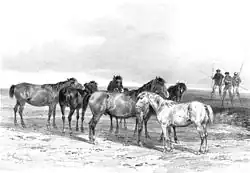Landais pony
 | |
At the Salon International de l'Agriculture in 2010 | |
| Conservation status | |
|---|---|
| Other names |
|
| Country of origin | France |
| Distribution | principally Nouvelle-Aquitaine |
| Standard | Haras Nationaux (page 7, in French} |
| Use | riding horse |
| Traits | |
| Height |
|
| Colour |
|

The Landais is an endangered French breed of small horse or pony. It originated in the marshy plains and woodlands of the département of the Landes, in the Nouvelle-Aquitaine region of south-western France, but is more often reared in the département of Pyrénées-Atlantiques, particularly in the arrondissement of Pau. Due to influences from Arab and Welsh blood, it shows more similarity to Oriental horses than to other Celtic breeds.[4]: 482 It is used for riding and driving, and is a good trotter.
History
Traditionally, two distinct types of pony or small horse lived in a feral or semi-feral state in the Landes de Gascogne region of south-western France: the Lédon or Poney des Pins in the sandy coastal areas of the Gironde and the Haute-Lande; and the Barthais in the Barthes de l'Adour, the marshy meadowlands of the valley of the Adour river.[5][6]
The plantation of the Landes forest and associated swamp drainage operations in the nineteenth century reduced the natural range of these horses. In 1913 the two populations totalled some 2000.[5][7]: 186 The advent of motorised transport led to a decline in the number of animals, both because their usefulness was reduced and because some were the cause of road accidents; during the Second World War, some fell victim to land-mines laid by German forces to prevent coastal landings. After the War, no more than 150 head remained.[5] The Poney des Pins became extinct in about 1950.[5][6]
Recovery of the breed – which now consisted only of the Barthais type – began in 1967,[5] and a stud-book for the Landais was established in that year.[2] To reduce the effects of inbreeding, some use was made of stallions of Arab and Welsh (Section B) types.[5]: 149 [8]
In 2007 the conservation status of the Landais was listed by the Food and Agriculture Organization of the United Nations as "critically endangered";[1]: 44 in 2014 the total number reported for the breed was 159.[2] Annual births are low: between 2006 and 2013 the number ranged from 36 to 66.[6]
A genetic study of French horse breeds in 2008 suggested that, to maximise genetic diversity among the French horse population, conservation priority be given to the Landais and four other breeds.[9]: 5
Some Landais ponies live in a semi-feral state with other livestock and wildlife on the banks of the Adour and Luy rivers in the area of Dax in the Landes,[5] but the largest number is found in the arrondissement of Pau, in the département of Pyrénées-Atlantiques. Others are reared elsewhere in Nouvelle-Aquitaine, and in the Auvergne-Rhône-Alpes, Centre-Val de Loire, Occitanie and Pays de la Loire regions.[6]
Characteristics
The Landais shows more similarity to Oriental horses than to Celtic breeds.[4]: 482 Arab influence can be seen in the head, while the small upright ears are from the Welsh heritage.[7]: 186 The legs are fine, the shoulders sloped, and the rump sloping and single. The mane is full, as is the tail, which is carried high.[3][7]: 186 The colours are bay, black, chestnut, liver chestnut, seal brown and chocolate;[3]: 8 [6] White markings to the face and legs are permitted.[3]: 8
Use
The Landais is used as a riding horse – often by children – for hacking out and trekking, and in competition sports such as jumping, eventing and dressage.[6] It is an excellent trotter, and is used in trotting races and in competitive driving; a Landais named Jongleur holds the trotting record for the 100-kilometre (62 mi) run between Paris and Chartres.[6]
The Landais was among the breeds used in the creation of the Poney Français de Selle or French Riding Pony.[7]: 186
References
- ^ a b Barbara Rischkowsky, Dafydd Pilling (editors) (2007). List of breeds documented in the Global Databank for Animal Genetic Resources, annex to: The State of the World's Animal Genetic Resources for Food and Agriculture. Rome: Commission on Genetic Resources for Food and Agriculture, Food and Agriculture Organization of the United Nations. ISBN 9789251057629. Archived 23 June 2020.
- ^ a b c Landais / France (Horse). Domestic Animal Diversity Information System of the Food and Agriculture Organization of the United Nations. Accessed June 2017.
- ^ a b c d Patrick Falcone (22 December 2011). Reglement du Stud-Book Français du Poney Landais (in French). Ministère de l'Agriculture, de l'Agroalimentaire et de la Forêt. Archived 12 April 2013.
- ^ a b Valerie Porter, Lawrence Alderson, Stephen J.G. Hall, D. Phillip Sponenberg (2016). Mason's World Encyclopedia of Livestock Breeds and Breeding (sixth edition). Wallingford: CABI. ISBN 9781780647944.
- ^ a b c d e f g Le Poney Landais (in French). Association Nationale du Poney Landais. Archived 24 February 2012.
- ^ a b c d e f g Le Landais (in French). Institut français du cheval et de l’équitation. Archived 20 July 2018.
- ^ a b c d Elwyn Hartley Edwards (1994). The Encyclopedia of the Horse. London; New York; Stuttgart; Moscow: Dorling Kindersley. ISBN 0751301159.
- ^ Maurizio Bongianni (1988). Simon & Schuster's Guide to Horses and Ponies. New York: Simon & Schuster, Inc. ISBN 0671660683.
- ^ Grégoire Leroy, Lucille Callède, Etienne Verrier, Jean-Claude Mériaux, Anne Ricard, Coralie Danchin-Burge, Xavier Rognon (2009). Genetic diversity of a large set of horse breeds raised in France assessed by microsatellite polymorphism. Genetics Selection Evolution. 41 (1): 5. doi:10.1186/1297-9686-41-5.
External links
- Cap Sud Ouest Les Poneys Landais des Barthes (extrait) [South West Cape The Landais Ponies of Barthes (extract)] (video) (in French). France 3 Nouvelle-Aquitaine. 30 April 2020.